Centauri Dreams
Imagining and Planning Interstellar Exploration
Probing von Neumann Expansion
Before getting into the paper I want to discuss today, I want to mention the new biography of John von Neumann by Ananyo Bhattacharya. I make no comment on The Man from the Future (W. W. Norton & Company, 2022) yet because while I have a copy, I haven’t had time to read it. But be aware that it’s out there – it’s getting good reviews, and given the impact of this remarkable figure on everything from programmable computers to game theory and the interstellar dispersion of civilizations, it’s a book you’ll at least want to stick on your reference list.

I figure anyone who masters calculus by the age of eight, as von Neumann is reputed to have done, is going to turn out to make a substantial contribution somewhere. I’m also interested in how polymaths function, moving with what seems effortless ease through diverse fields of study and somehow leaving their mark on each. What a contrast to our age of micro-specialization, where relentless drilling down into a single topic – and this seems true of most academic disciplines – is the mode of choice.
Image: John von Neumann, shown here with technology that might have been more to his taste, the 18,000 vacuum-tube strong ENIAC. One can only wonder what the sybaritic mathematician would have made of quantum computing. If only he were here to tell us.
It’s a good time for this book to come out, because von Neumann isn’t exactly in the spotlight these days. In a review in Science, Dov Greenbaum and Mark Gerstein note that he seems to have dropped out of public view:
In 2022…von Neumann could be the smartest person most people have never heard of. To wit, Google Trends shows that his online popularity last year was almost an order of magnitude less than that of Alan Turing, a contemporary in computing; Erwin Schrödinger, a predecessor in quantum mechanics; and Stephen Wolfram, a successor in the world of automata.
All fame is fleeting, but it’s also mutable, and the Bhattacharya biography should go some distance in pumping up von Neumann’s recognition. But let’s talk interstellar, where his name comes up today because Greg Matloff has just published a new paper dealing with what we now call ‘von Neumann probes.’ By this we simply mean probes that are self-replicating, a notion that originated with von Neumann and has now gone on to wide-ranging study. Throw self-replication and interstellar probes together and you generate various notions about how long it takes to populate the entire galaxy, as found in the work of, for example, Frank Tipler, Michael Hart and others.
Most of those exploring this space have been what Milan ?irkovi? calls ‘contact pessimists,’ who point out that if von Neumann probes could visit all stars with habitable planets in an entire galaxy, and do this within a small fraction of the galaxy’s age, their existence should be obvious. A more subtle school of thought holds that 1) dispersion need not be uniform and 2) a von Neumann probe may already be in our own Solar System, much less others, for we have only begun to explore deep space.
We can imagine these probes as having the built-in intelligence to make the interstellar crossing, which could be on the order of tens of thousands of years or more given that no biological crews need be involved. Around a target star, such a probe uses local resources – mining a native asteroid system, perhaps – to produce a new probe that, in turn, moves on to the next nearest star, or whatever target it chooses. Robert Freitas has considered self-replication in terms of nanotechnology, in which the size of the probe may be reduced to something as tiny as a needle packed with assemblers.
I come back to the question of biological crews, for without them (or perhaps given probes that carry biological materials that can be activated at destination), the von Neumann probes are free of the massive constraints of species lifespans. Miniaturize a probe to nanotechnological levels and a space-based solar-pumped laser array can push it up to relativistic velocities, possibly using materials like graphene or some kind of future metamaterial at levels of thickness no more than a single atom. But Matloff believes a 20-nm aluminum sail performing an Oberth maneuver (close pass by the Sun followed by a propulsive burn to maximize the gravity slingshot) could reach speeds in the range of 300 kilometers per second. That translates to one light year every 1,000 years.
Either way, we have a method to move human technologies out into the galaxy once our engineering is up to the challenge – the physics behind the project do not preclude this. So let’s imagine that we or some other civilization reach a stage in which we can build von Neumann probes and set them on their journeys. Matloff develops a conservative estimate of the expansion rate of a civilization using such probes.
Because of the vast canvas of time we have to work with given the age of our galaxy, we can afford to be quite conservative in our assumptions. Suppose that to minimize transit times, we say that civilizations doing this send out probes only when another star makes a close approach to the parent probe’s planetary system. Remember, the goal here is the eventual placement of probes galaxy-wide. We give up on all notions of probes reaching destinations within the lifetime of those who build them, even the lifetime of their civilization!
This gets intriguing, based on current data. The second data release of the Gaia space observatory tells us that a star like the Sun will pass within one light year of the Sun every half million years or so. This is, Matloff notes, a pretty conservative figure, for Gaia underestimates the number of low-mass red dwarfs that might also serve. Working the math, we come up with an estimated rate of expansion, granting that some stellar systems will not be suitable. After 500,000 years, we have but two occupied stellar systems. After 18 million years, we have 68.7 billion systems. Says Matloff:
This approach is only an approximation; not all stellar systems will be suitable for occupation by von Neumann probes, and some close stellar encounters will be repeated. But it does indicate that not many long-lived space-faring civilizations that deploy von Neumann probes are required to occupy the galaxy. Even if the slowest interstellar propulsion technique presented above — unpowered giant planet gravity assists — is the one selected by ET, the required galactic occupation time is not substantially increased.
Ah, the joys of exponential growth. I’m reminded of George Gamow’s treatment of such growth in his delightful One Two Three… Infinity, first published in 1947. With probes generating new probes and continuing to push outward, it becomes clear that it would not take a great number of spacefaring civilizations to occupy the entire galaxy even using nothing more than sundiver maneuvers or even gravity assists around gas giant planets to serve as the propulsion technique. Obviously, the process quickens if we reach relativistic speeds with nanotech probes that can exploit the resources they find. The process is fast enough that it’s inevitable to ask where such probes might be located if they are already here.
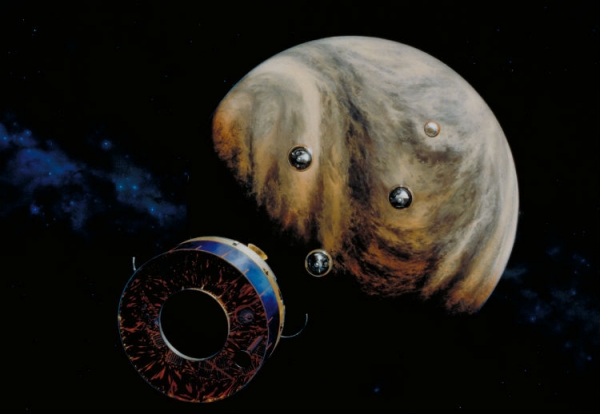
But first, why would a civilization choose to mount a campaign to spread through the galaxy using such probes? In the next post, we’ll consider a range of possible motivations.
The paper is Matloff, “Von Neumann probes: rationale, propulsion, interstellar transfer timing,” International Journal of Astrobiology, published online by Cambridge University Press 28 February 2022 (abstract).

HOEE: The Starshade and the Ground
I always keep an eye on the Phase I and Phase II studies in the pipeline at the NASA Innovative Advanced Concepts (NIAC) program. The goal is to support ideas in their early stages, with the 2022 awards going out to 17 different researchers to the tune of a combined $5.1 million. Of these, 12 are Phase I studies, which deliver $175,000 for a nine-month period, while the five Phase II awards go to $600,000 over two years. We looked at one of the Phase I studies, Jason Benkoski’s solar-thermal engine and shield concept, in the last post. Today we go hunting exoplanets with a starshade.
This particular iteration of the starshade concept is called Hybrid Observatory for Earth-like Exoplanets (HOEE), as proposed by John Mather (NASA GSFC). Here the idea is to leverage the resources of the huge ground-based telescopes that should define the next generation of such instruments – the Giant Magellan Telescope, the Extremely Large Telescope, etc. – by using a starshade to block the glare of the host star, thus uncovering images of exoplanets. Remember that at visible wavelengths, our Sun is 10 billion times brighter than the Earth. The telescope/starshade collaboration would produce what Mather believes will be the most powerful planet finder yet designed.

Image: Three views of a starshade. Credit: NASA / Exoplanet Exploration Program.
Removing the overwhelming light of a star can be done in more than one way, and we’ve seen that an internal coronagraph will be used, for example, with the Nancy Grace Roman Space Telescope. It’s what NASA describes as “a system of masks, prisms, detectors and even self-flexing mirrors” that is being built at the Jet Propulsion Laboratory for the mission.
In conjunction with a space telescope, a starshade operates as a separate spacecraft, a large, flat shade positioned tens of thousands of kilometers away. Starshades have heretofore been studied in this configuration, so the innovation in Mather’s idea is to align the starshade with instruments on the ground. His team believes that we could detect oxygen and water on an Earth-class planet using a 1-hour spectrum out to a distance of 7 parsecs (roughly 23 light years. In an ASTRO2020 white paper, Mather described a system like this using a different orbit for each target star, with the orbit being a highly eccentric ellipse. Thrust is obviously a key component for adjusting the starshade’s position for operations.
From the white paper:
An orbiting starshade would enable ground-based telescopes to observe reflected light from Earth-like exoplanets around sun-like stars. With visible-band adaptive optics, angular resolution of a few milliarcseconds, and collecting areas far larger than anything currently feasible for space telescopes, this combination has the potential to open new areas of exoplanet science. An exo-Earth at 5 pc would be 50 resolution elements away from its star, making detection unambiguous, even in the presence of very bright exo-zodiacal clouds. Earth-like oxygen and water bands near 700 nm could be recognized despite terrestrial interference…
And what a positioning challenge this is in order to maximize angular resolution, sensitivity and contrast, with the starshade matching position and velocity with the telescope from an orbit with apogee greater than ~ 185,000 km, thus casting a shadow of the star, while leaving the light of its planets to reach the instrument below. In addition to the active propulsion to maintain the alignment, the concept relies on adaptive optics that will in any case be used in these ground instruments to cope with atmospheric distortion. Thus low-resolution spectroscopy becomes capable of analyzing light that is actually reflected from Earth-like planets.
Mather’s team wants to cut the 100-meter starshade mass by a factor of 10 to support about 400 kg of thin membranes making up the shade. Thus the concept of an ultra-lightweight design that would be assembled – or perhaps built entirely – in space. It’s worthwhile to remember that the starshade concept in orbit is a new entry in a field that has seen study at NASA GSFC as well as JPL’s Team X, with suitability considered for various missions including HabEx, WFIRST, JWST, New Worlds Explorer, UMBRAS and THEIA. The Mather plan is to create a larger, more maneuverable starshade, as it will indeed have to be to make possible the alignments with ground observatories contemplated in the study.
It’s an exciting prospect, but as Mather’s NIAC synopsis notes, the starshade is not one we could build today. From the synopsis:
The HOEE depends on two major innovations: a ground-space hybrid observatory, and an extremely large telescope on the ground. The tall pole requiring design and demonstration is the mechanical concept of the starshade itself. It must satisfy conflicting requirements for size and mass, shape accuracy and stability, and rigidity during or after thruster firing. Low mass is essential for observing many different target stars. If it can be assembled or constructed after launch, it need not be built to survive launch. We believe all requirements can be met, given sufficient effort. The HOEE is the most powerful exoplanet observatory yet proposed.
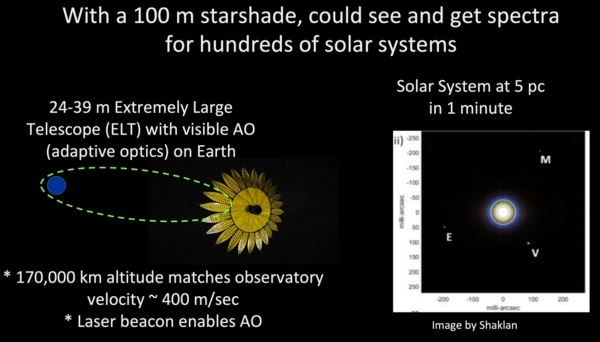
Image: Graphic depiction of Hybrid Observatory for Earth-like Exoplanets (HOEE). Credit: John Mather.
Centauri Dreams readers will know that Ashley Baldwin has covered starshade development extensively in these pages. His WFIRST: The Starshade Option is probably the best place to start for those who want to delve further into the matter, although the archives contain further materials. Also see my Progress on Starshade Alignment, Stability.
For more, see Peretz et al., “Exoplanet imaging performance envelopes for starshade-based missions,” Journal of Astronomical Telescopes, Instruments, and Systems 7(2), 021215 (2021). Abstract. And for an overview: Arenberg et al., “Special Section on Starshades: Overview and a Dialogue,” Journal of Astronomical Telescopes, Instruments, and Systems 7(2), 021201 (2021). Abstract.

Engineering the Oberth Maneuver
As we saw recently with the analogy of salt grains for stars, the scale of things cosmic stuns the imagination. But we don’t have to go to galactic scale. We can stay much closer to home and achieve the same effect. Because at our current technological levels, getting even as far as the outer planets taxes our capabilities. The least explored types of planet in our Solar System are the dwarf worlds, places like Ceres, Pluto and Charon, not to mention the enigmatic Triton. It takes years to reach them.
Beyond these objects we have a wide range of other dwarfs that merit study, at distances that push us ever farther. In a description of their NIAC Phase I study, just announced as a selection for 2022, Jason Benkoski and colleagues at Johns Hopkins University look into a combination heat shield and solar propulsion system that would perform a close Solar pass and use the Sun’s gravity to slingshot outwards at the highest possible velocity. It’s a maneuver familiar to Centauri Dreams readers, and one recently examined by the Interstellar Probe team at JHU’s Applied Physics Laboratory.
Benkoski is a materials scientist who has been working with the APL team, envisioning a tight solar pass around the Sun followed by the firing of a thruster to enhance the craft’s acceleration. This will require the probe to move within 1.6 million kilometers of the Sun’s surface, actually four times closer than the Parker Solar Probe plans to reach by 2025. In a 2021 article in Johns Hopkins Magazine, Benkoski explained the concept, which will preserve the heat shield by using channels filled with hydrogen gas that are built into the bulk of the shield itself. As the article puts it:
During the probe’s searing slingshot around the sun, the gas would heat up, expand, and course through the channels that all lead to a single exhaust nozzle. “The idea is to absorb all this heat with hydrogen,” Benkoski says, “and shoot it out the back of the probe.” In this way, the cooling setup also opportunistically doubles as an engine, thus supplying the thrust needed to complete the Oberth maneuver in the first place. “It’s like hitting two birds with one stone,” Benkoski says.
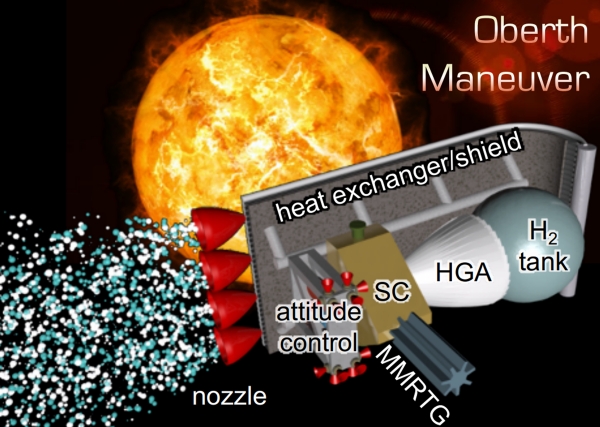
Image: Graphic depiction of combined heat shield and solar thermal propulsion system for an Oberth maneuver. Credit: Jason Benkoski.
The team believes that advances in materials science and engineering make their solar thermal engine concept a workable model for development. The 20 x 20 cm prototype they designed and fabricated is at benchtop scale, using liquid helium as coolant and propellant. The new study will extend this work, taking the concept into the realm of realistic materials and propellants. No small challenge, that, given that the contemplated Oberth maneuver would subject the probe to temperatures of 2500 degrees C, enough to melt even the Parker Solar Probe’s heat shield.
Benkoski points out that neither of our Voyagers was designed for observing the interstellar medium through which it now passes, while of course the Pioneers have long since ceased to function. New Horizons remains thankfully robust but will ultimately succumb to dwindling power levels and lose communications with Earth. The numbers are daunting: The Voyagers managed 3.6 AU per year, while even a full-stack SLS (which will never fly this mission) would push a 1 tonne spacecraft only to 8 AU per year.
The latter would require not just a working SLS but a Jupiter gravity assist, limiting the fly-out direction of our probes. Hence the need for a solar Oberth maneuver, in Benkoski’s thinking, which would be capable of surviving temperatures of 2800 K and use propellants now under study to widen the range of potential mission targets:
We…therefore propose a full trade study of alternate propellants in order to determine the maximum escape velocity for a given total system mass, including spacecraft, heat shield, propellant storage, and attitude control system. The main propellants of interest include H2, LiH, Li, CH4, NH3, and H2O. Methods: First we would determine material compatibility for each propellant with respect to its proposed storage system. We then calculate the efficiency (specific impulse) as a function of temperature for each propellant using Chemical Equilibrium Analysis (CEA).
Benkoski intends to discover how the mass and storage volume of the tank scale with the quantity of propellant to produce a series of realistic tank designs, devising an equation for the heat shield area and maximum propellant fraction that can be achieved given the limitations of existing heavy boosters. We’ll see how this study fares in producing a full-scale heat shield/heat exchanger design with robust long-term cryogenic storage. A tight Oberth maneuver is not going to be easy. See Assessing the Oberth Maneuver for Interstellar Probe for some of the myriad reasons why.

Lowering the Laser Barrier
The continuing release of papers related to or referring to the Breakthrough Starshot sail concept is good news for the entire field. Interstellar studies as an academic discipline has never had this long or sustained a period of activity, and the growing number of speakers at space-related conferences attests to the current vitality of starflight among professionals and the general public alike.
Not all interstellar propulsion concepts involve laser-beaming, of course, and we’ll soon look at what some would consider an ever more exotic concept. But today I’m focusing on a paper from Ho-Ting Tung and Artur Davoyan, both in the Mechanical and Aerospace Engineering Department at UCLA. You could say that these two researchers are filling in some much needed space between the full-bore interstellar effort of Breakthrough Starshot, the Solar System-oriented laser work of Andrew Higgins’ team at McGill, and much smaller, near-term experiments we could run not so far from now.
Of the many potential show-stoppers faced by a mission to another star at our stage of development is the need to develop the colossal laser array envisioned by Starshot. The Higgins array is at a smaller scale, as befits a concept with nearby targets like Mars. What Tung and Davoyan envision are tiny payloads (here they parallel Breakthrough), some no more than a gram in mass, but the authors push the sail with a 100 kW array about a meter in size. Compare this with Breakthrough’s need for a gigantic square-kilometer array of 10 kW lasers with a combined output of up to 100 GW.
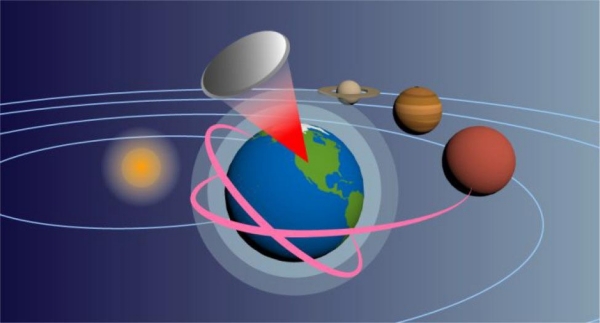
Image: In this illustration, a low-power laser (red cone) on Earth could be used to shift the orbit (red lines) of a small probe (grey circle), or propel it at rapid speeds to Neptune and beyond. Credit: Ho-Ting Tung et al.
The UCLA work takes us to a consideration of operations with spacecraft in Earth orbit as well as payloads sent on interplanetary trajectories. Thus we are in the realm of the kind of missions that today would demand chemical or electric propulsion, and we are looking at a system that might be used, for example, for orbital adjustment of Earth satellites after launch, or in the case of chip-class payloads, interplanetary missions with surprising velocities, up to 5 times that of New Horizons. As noted, the needed laser aperture is, by the standards of the missions we’ve discussed earlier, small:
…a sail with w = 1 m would require a laser with an aperture D ? 26 m (compare with the 30 m diameter primary mirror of the Thirty Meter Telescope under construction). However, we stress that most practical scenarios are limited to low and medium Earth orbits that require a much shorter operation range (z ? 1000km), and therefore a significantly smaller laser array.
Indeed, an array a meter in size could be efficient, maneuvering small satellites in Earth orbit, or being used to bring small chip-craft up to Solar System escape velocity. Thus we have the potential to create laser propulsion experiments and missions with array powers of ? 100 kW and array sizes that do not require kilometers of desert for their construction. Payloads can range from 1 to 100 grams depending on the mission, though the focus here is wafer-scale, on the order of 10 centimeters.
As to sail materials, the authors calculate that for maximum reflectivity coupled with rapid cooling, silicon nitride and boron nitride are the materials of choice:
Broadband spectral emissivity of silicon nitride…results in a better heat rejection (i.e., lower temperature) as compared [to] narrow band BN thermal emitters. However, boron nitride being lighter than silicon nitride allows design of very light-weight light-sails, which eventually translates onto higher velocity gain, ?v.
The paper offers possible ways to create these structures, including using metamaterials formed into nanostructured architectures with nanometer-scale ‘sandwich’ panels between material layers, or using ‘micro pillars’ within the photonic structure.
The broader picture is that we’re mapping out how to experiment with lasers and materials that may begin moving up the ladder of mission complexity. There are innumerable issues to be overcome, but the early theoretical work is crucial to making what may become an interplanetary infrastructure a reality. These examinations should also feed into the ambitious work on projects that aim at interstellar missions.
The paper is Ho-Ting Tung et al, Low-Power Laser Sailing for Fast-Transit Space Flight, Nano Letter,” Nano Letters 22, 3 (31 January 2022), 1108–1114 (abstract).

Delving into the Interstellar Sail
One of the benefits of a project like Breakthrough Starshot is that it moves the ball forward in terms of the academic research that underpins advances in technologies. I seriously doubt that Starshot will result in an Alpha Centauri probe reaching these stars within the next 50 years, given among other things the conundrum of data retrieval from a fleet of chip-sized micro-craft. But we all gain from the fact that scientists are tackling these issues in a well-funded and coordinated way. The research library grows.
As a field, interstellar studies has always been resource-starved, not to mention winning scant attention among the larger community of scientists and engineers at conferences and in publications. But it has drawn on a consistent thread of interest that now gains new energies. That benefits the entire effort. And let’s not forget the power of looking far into the future to get a conception of what we can do with scaled-down projects in the near term, as for example Andrew Higgins’ laser-fed fast missions to Mars.
Starshot, of course, takes the laser concept into the interstellar realm, using a massive ground-based array that would likely be based in Chile’s Atacama Desert. The laser array is used to push meter-scale sails, making Starshot’s committee on sail design a major component of the effort. The infusion of funding into sail technologies is welcome, as it leads to new insights into a sail’s shape, its size and its materials.

Image: An artist’s conception of the Starshot Lightsail spacecraft during acceleration by a ground-based laser array. Previous conceptions of lightsails have imagined them being passively pushed by light from the sun, but Starshot’s laser-based approach requires rethinking the sail’s shape and composition so it won’t melt or tear during acceleration. Credit: Masumi Shibata, courtesy of Breakthrough Initiatives.
Thus the significance of Igor Bargatin’s work. An associate professor at the University of Pennsylvania in the Department of Mechanical Engineering and Applied Mechanics, Bargatin and colleagues at the university as well as at UCLA have just published two papers going through fundamental sail issues and specifications. Remember that the projected sails, perhaps three-meters wide and a thousand times thinner than a sheet of paper, are to be subjected to a light intensity millions of times that of the Sun.
The team sees these sails as being made of ultrathin sheets of aluminum oxide and molybdenum disulfide, constructed in a parachute shape rather than a flat surface. The structure would be about as deep as it is wide, allowing the greatest ability under these calculations of withstanding the strain of the sudden acceleration, which is expected to reach tens of thousands of g’s. A ‘billowing’ sail should hold up to the strain better than a tight, flat one, providing a surface that is more resistant to tears.
Matthew Campbell is a postdoctoral researcher in Bargatin’s group and lead author of the paper covering the sail’s shape:
“Laser photons will fill the sail much like air inflates a beach ball. And we know that lightweight, pressurized containers should be spherical or cylindrical to avoid tears and cracks. Think of propane tanks or even fuel tanks on rockets.”
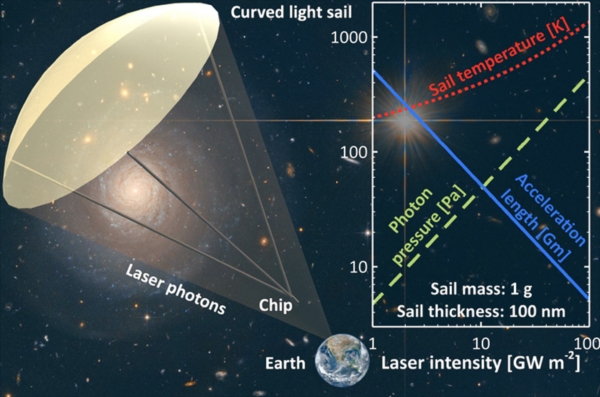
Image: Campbell et al. show that the diameter and radius of curvature of a circular light sail should be comparable in magnitude, both on the order of a few meters, in optimal designs for gram-scale payloads. Credit: Campbell et al.
The second paper, led by UCLA engineer Aaswath Raman, examines sail materials, offering insights into how heat will be dissipated under the powerful laser beam. Here the idea is to use nano-scale patterning within the material to manage the heat. Says Raman:
“If the sails absorb even a tiny fraction of the incident laser light, they’ll heat up to very high temperatures. To make sure they don’t just disintegrate, we need to maximize their ability to radiate their heat away, which is the only mode of heat transfer available in space.”
While earlier research maximized heat dissipation through a photonic crystal design that deployed regularly spaced holes in the sail material, the new work suggests adding a grid-like pattern for the ‘fabric,’ with the spacing of the holes matching the wavelength of light, and the swatches of sail material forming the grid spaced to match the wavelength of the thermal emission. The result is a stronger sail, one that could endure a higher initial thrust and therefore need less time under the beam.
The mathematics involved here is of a complexity far above my pay grade. I’ll have to send you to the paper for the details. But I think we can visualize the sail internals as a kind of ‘scaffolding’ that is apparent in the image below. The reference to ‘Mie resonant features’ in the caption to this image points to the work of Gustav Mie, who described what we now call ‘Mie scattering,’ showing the behavior of light of various wavelengths as it strikes particular kinds of structures. Mie resolved the intricate mathematics of these interactions.

Image: This is Figure S4 from the paper. Caption: Continuous Mie structure design. The black outlines serve to highlight the positions of the Mie resonant features against the continuous reflective green layer, but would not exist in the actual design. Credit: Brewer et al.
UCLA’s Deep Jariwala, who was involved with both papers, comments:
“A few years ago, even thinking or doing theoretical work on this type of concept was considered far-fetched. Now, we not only have a design, but the design is grounded in real materials available in our labs. Our plan for the future would be to make such structures at small scales and test them with high-power lasers.”
Thus the theoretical work continues. Exactly when it pays off in hardware and actual missions is something we cannot know.
The papers are Campbell et al., “Relativistic Light Sails Need to Billow,” Nano Letters 22, 1 (2022), 90-96 (abstract); and Brewer et al., “Multiscale Photonic Emissivity Engineering for Relativistic Lightsail Thermal Regulation,” Nano Letters 22, 2 (2022), 594-601 (abstract).

Galaxies Like Grains of Salt
I’m riffing on a Brian Aldiss title this morning, the reference being the author’s 1959 collection Galaxies Like Grians of Sand, which is a sequence of short stories spanning millions of years of Earth’s future (originally published as The Canopy of Time). But sand is appropriate for the exercise before us today, one suggested by memories of the day my youngest son told me he had to construct a model of an atom and we went hunting all over town for styrofoam balls. It turns out atoms are easy.

Suppose your child comes home with a project involving the creation of a scale model of the galaxy. Pondering the matter, you announce that grains of salt can stand in for stars. Sand might work as well, but salt is easier because you can buy boxes of salt at the grocery. So while your child goes outside to do other things, you and your calculator get caught up in the question of modeling the Milky Way. Just how much salt will you need?
Most models of the galaxy these days come in at a higher number than the once canonical 100 billion stars. In fact, 200 billion may be too low. But let’s economize by sticking with the lower number. So you need 100 billion grains of salt to make your scale model accurate. A little research reveals that the average box of Morton salt weighs in with about five million grains. Back to the calculator. You will need 20,000 boxes of salt to make this work. The local grocery doesn’t keep this much in stock, so you turn to good old Amazon, and pretty soon a semi has pulled up in front of your house with 20,000 blue boxes of salt.
But how to model this thing? I wouldn’t know where to begin, but fortunately JPL’s Rich Terrile thought the matter through some time back and he knows the answer. If we want to reflect the actual separation of stars just in the part of the galaxy we live in, we have to separate each grain of salt by eleven kilometers from any of its neighbors. Things get closer as we move in toward the bulge. Maybe your child has lots of friends to help spread the salt? Let’s hope so. And plenty of room to work with for the model.
I mention all this because I was talking recently with Nate Simpson, lead developer of Kerbal Space Program 2, and colleague Jon Cioletti. This is the next iteration of the remarkable spaceflight simulation game that offers highly realistic launch and orbital physics capabilities. We were talking deep space, and the salt box comparison came naturally, because these guys are also in the business of reaching a broader audience with extraordinary scales of time and space.
I strongly recommend Kerbal, by the way, because I suspect Kerbal Space Program has already turned the future career path of more than a few young players in the direction of aerospace, just as, say, science fiction novels or Star Trek inspired an earlier generation in that direction. Watching what develops as Kerbal goes into version 2 will be fascinating.
Unexpected Interstellar Targets
But I was also thinking about the salt box analogy because it can be so difficult to get interstellar distances across to the average person, who may know on some level that a galaxy is a very big place, but probably doesn’t have that deep awe that a real acquaintance with the numbers delivers. I think about craft trying to navigate these immensities, and also about objects like ‘Oumuamua and 2I/Borisov, the first two known interstellar objects we have detected. What vast oceans of interstellar space such tiny objects have drifted through! Clearly, as our ability to observe them grows, we’ll find many more such objects, and one of these days we’ll get a mission off to study one up close (probably designed by Andreas Hein and team).
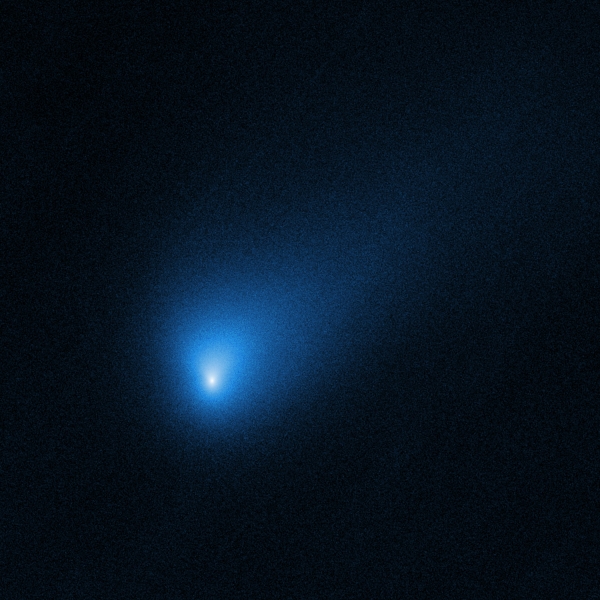
Image: This Hubble Space Telescope image of 2I/Borisov shows the first observed rogue comet, a comet from interstellar space that is not gravitationally bound to a star. It was discovered in 2019 and is the second identified interstellar interloper, after ‘Oumuamua. 2I/Borisov looks a lot like the traditional comets found inside our solar system, which sublimate ices, and cast off dust as they are warmed by the Sun. The wandering comet provided invaluable clues to the chemical composition, structure, and dust characteristics of planetary building blocks presumably forged in an alien star system. It’s rapidly moving away from our Sun and will eventually head back into interstellar space, never to return. Credit: NASA, ESA, and D. Jewitt (UCLA).
I was heartened to learn over the weekend that the James Webb Space Telescope will likely have a role to play in further detection efforts. Indeed, there is now a Webb Target of Opportunity program that homes in on just such discoveries. Here is how a Target of Opportunity is defined on the JWST website:
A target for JWST observation is deemed a Target of Opportunity (ToO) if it is associated with an event that may occur at an unknown time, and in this way ToOs are distinct from time constrained observations.
Sounds made to order for interstellar interlopers. But we can add this:
ToO targets include objects that can be identified in advance, but which undergo unpredictable changes (e.g., some dwarf novae), as well as objects that can only be identified in advance by class (e.g., novae, supernovae, gamma ray bursts, newly discovered comets, etc.). ToOs are generally not suitable for observations of periodic phenomena (e.g., eclipsing binary stars, transiting planets, etc.). ToO proposals must provide a clear definition of the trigger criteria and present a detailed plan for the observations to be performed in the technical justification of the PDF submission if the triggering event occurs. A ToO activation may consist of a single observation or of a set of observations executed with a pre-specified cadence.
Martin Cordiner (NASA GSFC/Catholic University of America) is principal investigator of the Webb Target of Opportunity program to study the composition of an interstellar object:
“The supreme sensitivity and power of Webb now present us with an unprecedented opportunity to investigate the chemical composition of these interstellar objects and find out so much more about their nature: where they come from, how they were made, and what they can tell us about the conditions present in their home systems, The ability to study one of these and find out its composition — to really see material from around another planetary system close up — is truly an amazing thing.”

Image: This artist’s illustration shows one take on the first identified interstellar visitor, 1I/’Oumuamua, discovered in 2017. The wayward object swung within 38 million kilometers of the Sun before racing out of the solar system. 1I/’Oumuamua still defies any simple categorization. It did not behave like a comet, and it had a variety of unusual characteristics. As the complex rotation of the object made it difficult to determine the exact shape, there are many models of what it could look like. Credit: NASA, ESA, and J. Olmsted and F. Summers (STScI).
When astronomers detect another interstellar interloper, they’ll first need to confirm that it’s on a hyperbolic orbit, and if JWST is to come into play, that its trajectory intersects with the telescope’s viewing field. If that’s the case, Cordiner’s team will use JWST’s Near-Infrared Spectrograph (NIRSpec) to examine gasses released by the object due to the Sun’s heat. The spectral resolution available here should allow the detection of molecules ranging from water, methanol, formaldehyde and carbon dioxide to carbon monoxide and methane. The Mid-infrared instrument (MIRI) will track any dust or solid particles produced by the object.
The near- and mid-infrared wavelength ranges will be used to examine interstellar interlopers for the first time with this program, making this fertile ground for new discoveries. The assumption being that such objects exist in vast numbers, the Webb Target of Opportunity program should find material to work with, and likely soon, especially given JWST’s ability to detect incoming objects at extremely faint magnitudes. Are most such discoveries likely to be comet-like, or do we have the possibility of finding other objects as apparently anomalous as ‘Oumuamua?


